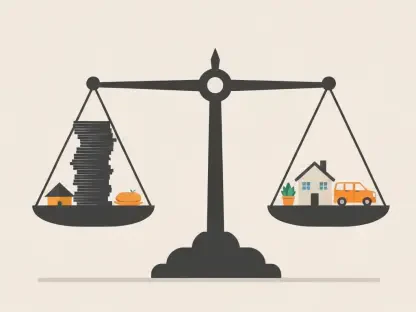In the ever-shifting landscape of the U.S. banking sector, a single event can send ripples through markets and investor confidence alike, as demonstrated by First Guaranty Bancshares (FGBI.O), a regional financial institution based in Louisiana. This bank has captured attention with a staggering third-quarter net loss of $45 million, a dramatic downturn compared to a modest profit of $1.9 million in the same quarter last year, underscoring the fragility of even well-established banks when faced with concentrated credit risks. The loss, primarily driven by exposure to a bankrupt auto parts manufacturer, raises pressing questions about risk management and market stability. This analysis aims to dissect the factors behind this financial setback, explore its implications for broader banking trends, and project potential pathways forward in a climate of economic uncertainty.
Diving into Market Dynamics: What Led to the Loss?
Credit Exposure Crisis: A $52M Anchor
At the core of First Guaranty Bancshares’ financial woes lies a substantial $52 million credit exposure linked to commercial lease financing with entities tied to a bankrupt auto parts manufacturer. The manufacturer’s filing for Chapter 11 bankruptcy protection triggered a sharp reassessment of risk, prompting the bank to escalate its provisions for credit losses to $47.9 million—a nearly tenfold increase from $4.9 million a year ago. This move reflects a cautious stance on the potential non-recovery of funds, highlighting how vulnerabilities in specific industries can disproportionately impact regional banks. Similar challenges have surfaced across the sector, with larger institutions like Fifth Third and JPMorgan Chase also reporting losses tied to insolvencies in auto parts and related fields, pointing to a pattern of risk in cyclical markets.
Goodwill Impairment: Deepening the Financial Wound
Adding to the strain, First Guaranty recorded a $12.9 million goodwill impairment charge, a direct consequence of its stock trading below book value amid heightened provisions for bad loans. This accounting adjustment signals a decline in market confidence and a reassessment of the bank’s intangible assets, a trend not uncommon among regional banks under financial duress. Such impairments often emerge during periods of underperformance, as market perceptions shift toward skepticism about future growth. While this charge helps align the bank’s balance sheet with current realities, it also risks prolonging investor hesitance, potentially limiting access to capital in the near term.
Stock Market Fallout: Investor Confidence Shaken
The market reaction to First Guaranty’s financial disclosure was immediate and unforgiving, with the bank’s stock plummeting 17.5% in a single day to a seven-month low, followed by an additional 1.2% drop shortly after. Year-to-date, shares have declined by a significant 42.3%, mirroring broader investor concerns about credit risk management in the banking sector. This selloff aligns with a wider trend of unease, as isolated bankruptcies in industries like auto parts and subprime lending have triggered volatility in banking stocks. While some market analysts suggest this dip may present a buying opportunity for risk-tolerant investors, others warn that persistent credit concerns could continue to weigh heavily on valuations.
Analyzing Trends: Credit Risks in the Banking Sector
Emerging Patterns: Concentration Risks Under Scrutiny
The U.S. banking industry, while generally maintaining strong credit quality, faces growing scrutiny over concentrated exposures in volatile sectors. First Guaranty’s predicament exemplifies how reliance on specific industries, such as manufacturing, can lead to outsized losses when economic conditions sour. Data from recent quarters indicates a rise in provisions for credit losses among regional banks, as institutions brace for potential defaults in cyclical markets. This trend suggests a shift toward more conservative lending practices, with banks reevaluating portfolios to mitigate similar risks, a response driven by both market pressures and regulatory expectations.
Future Projections: Adapting to Economic Headwinds
Looking ahead, projections for the banking sector point to a period of cautious recalibration from 2025 to 2027, as institutions like First Guaranty seek to balance growth with stability. Technological innovations, including AI-driven risk assessment tools, are expected to play a pivotal role in identifying portfolio vulnerabilities before they escalate. Additionally, potential regulatory changes aimed at tightening lending standards could reshape how banks approach high-risk industries. While systemic risks remain low, isolated incidents are likely to persist as tests of individual resilience, pushing banks to diversify exposures and bolster reserves as a buffer against unforeseen shocks.
Comparative Insights: Learning from Industry Peers
Examining the broader market, the challenges faced by First Guaranty are not entirely unique. Larger banks have encountered parallel issues, with losses tied to specific sector downturns revealing shared vulnerabilities. However, the scale of impact varies, as regional players often lack the diversified revenue streams of national giants, making them more susceptible to localized or industry-specific crises. This disparity underscores a critical need for smaller banks to adopt risk mitigation strategies akin to those of their larger counterparts, such as enhanced stress testing and cross-sector lending, to weather economic turbulence more effectively.
Reflecting on the Analysis: Strategic Takeaways
Looking back, the $45 million loss reported by First Guaranty Bancshares serves as a stark reminder of the inherent risks tied to concentrated credit exposures in volatile industries. The interplay of a $52 million credit burden from a bankrupt auto parts manufacturer and a $12.9 million goodwill impairment charge paints a sobering picture of financial strain, amplified by a severe stock decline. For industry stakeholders, this event highlights the urgency of robust risk management frameworks. Moving forward, banks are encouraged to prioritize real-time portfolio monitoring, diversify lending across sectors, and leverage advanced analytics to preempt potential crises. Transparent communication with investors also emerges as a vital step to rebuild trust, ensuring that such setbacks can be navigated with strategic foresight in an unpredictable economic landscape.









